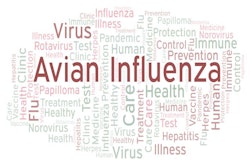
In Hungary, the recent highly pathogenic avian influenza (HPAI) spike continues to cause heavy losses at commercial poultry farms across three counties in the south and northeast of the country.
Over the past two weeks, 23 new outbreaks linked to the H5N1 HPAI virus variant have been officially reported by the national veterinary agency.
According to notifications to the World Organisation for Animal Health (OIE), these involved a total of more than 805,000 birds.
With the largest flocks affected comprising more than 103,000 birds, almost all outbreaks in Hungary continue to hit commercial premises with fattening or foie-gras ducks or geese. Of the latest outbreaks, 17 were in Bacs-Kiskun in the south of Hungary, with the others in neighboring Csongrad-Csanad, and in the northeast in Szabolcs-Szatmar-Bereg.
Since the country’s first cases were detected in the current disease wave in mid-April, Hungary has notified the OIE about 154 outbreaks on farms. Total losses of poultry through mortality or culling are close to 2.65 million.
Outbreak total in European poultry approaches 1,700
As of May 20, 1,675 HPAI outbreaks have been registered across Europe so far in 2022. This is according to the latest update of the Animal Disease Information System by the European Commission (EC). To date in 2022, one or more outbreaks have occurred in19 European countries over this period.
This year’s figure approaches the total of 1,756 outbreaks registered with the EC by 24 European states throughout 2021.
Of the 95 new outbreaks since the previous update on May 6, the highest increase — 82 — was recorded in Hungary. Registering an increase of 11, France remains the worst-affected country in Europe, now with a total of 1,293 outbreaks so far this year. In addition, one new outbreak has been reported to the EC by Germany and Moldova.
Now with a total of 176, Hungary has registered Europe’s second highest outbreak total for 2022 so far. Next comes the Netherlands with an unchanged 35.
Further poultry outbreaks reported in 5 countries
In eastern Europe, the Republic of Moldova has officially registered its first cases of HPAI linked to the H5N1 virus serotype in a second district.
According to the official OIE notification, more than 450 poultry died out of around 4,200 birds in backyard flocks from mid-May. Comprising various species, these were in a village in Ungheni. Located in the west of the country, this district borders Romania.
At the start of 2022, one outbreak occurred in neighboring Telenesti. The disease series was closed shortly afterwards with no further reported cases.
In its latest update on HPAI, the agriculture ministry of France has confirmed a total of 1,382 HPAI outbreaks on poultry farms in the country, with infections also in 35 backyard flocks. This was the status on May 24, and represents increases of just one outbreak in each category. Both were in departments where previous cases have been confirmed.
In the Netherlands, one new HPAI outbreak has been reported to the OIE over the past 10 days. This involved a hobby flock of 1,181 pheasants in the area of Boskoop in South Holland.
According to the Dutch agriculture ministry, HPAI has also affected a small hobby farm in the same area. Comprising a mixed flock of at-risk species, 590 birds were culled at the premises last week.
In the north German state of Schleswig-Holstein, the H5N1 HPAI virus was detected in a backyard flock comprising 17 poultry. According to the OIE report, this occurred in mid-May.
Not included in the EC figures is the United Kingdom (U.K.). A new outbreak has been reported at a smallholding near Southwell in Nottinghamshire earlier this month. It brings to 98 the number of HPAI outbreaks in English poultry flocks this year, according to the agriculture department, Defra.
This latest case underscores official advice to poultry owners to remain vigilant and to maintain high levels of biosecurity.
Although the requirement to keep poultry housed in England, Scotland, and Wales was lifted on May 2, other restrictions linked to the Avian Influenza Prevention Zone (AIPZ) remain in place, according to Defra.
Earlier this week, it was announced that HPAI restrictions have also now been lifted in Northern Ireland.
5 countries declare HPAI situation resolved in poultry
According to recent reports from Germany’s animal health agency, the HPAI situation is now over in seven states. These are Bavaria, Brandenburg, Lower Saxony, Mecklenburg-West Pomerania, Saxony-Anhalt, Schleswig-Holstein, and Thuringia. The virus involved was an H5N1 subtype. In these states, directly impacted were a total around 609,000 poultry at 58 locations, starting between October of 2021 and early April.
In another part of Germany — North Rhine-Westphalia — HPAI is ongoing, with new cases confirmed as recently as mid-April.
Also registering with the OIE that the HPAI situation is closed is Bulgaria. In four provinces, a total of 13 HPAI outbreaks occurred in poultry between April and May. These involved more than 531,000 poultry in Gabovo, Pleven, Plovdiv, and Stara Zagora. The virus involved in this country’s outbreaks is reported as “untyped.”
To the OIE, veterinary authorities in Belgium and the Czech Republic have recently declared H5N1 HPAI outbreak series “resolved” in their respective countries. In both cases, the declarations followed a single outbreak on a poultry farm earlier this year.
In November of 2021, HPAI was confirmed at two poultry farms in the same area of Rogaland in southern Norway. With no further cases identified in the meantime, this outbreak series also now closed. As a result, the regulation to keep poultry housed or in a fenced area with a solid roof in selected areas has been lifted, along with a ban on hunting in high-risk locations.
Further HPAI cases in European wild birds
For the year to date, HPAI outbreaks in wild birds across Europe reported to the EC notification system have reached 1,746 (as of May 20).
This represents an increase of 52 from the position on May 6. Of these, 21 were reported by Germany, which now accounts for 882 of the region’s total, and 15 in the Netherlands.
Also confirming with the EC new outbreaks over the previous two weeks were Bulgaria, Denmark, France, Norway, Spain, and Sweden.
In Norway, wild birds have tested positive for the H5N5 HPAI virus serotype. All other European countries have confirmed the presence of the H5N1 virus variant in recent wild bird outbreaks.
In France, the agriculture ministry report that HPAI has been detected in a total of 51 wild birds. Representing an increase of four over the period May 13-24, these include first cases from the Hauts-de-France region in the north of the country.
Based on recent notifications to the OIE, a further 28 wild birds in the U.K. have tested positive for the H5N1 HPAI virus.
In the Republic of Ireland, six more birds have tested positive for the same virus variant, according to the same organization.
Furthermore, the H5N1 serotype was detected in two more wild birds in different regions of Finland during April.
Also to the OIE, the veterinary agencies of the Czech Republic and North Macedonia have recently declared the HPAI situation in their respective countries “closed.”
View our continuing coverage of the global avian influenza situation.

















